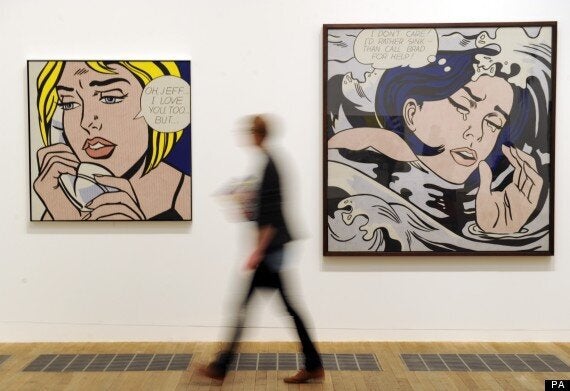
Roy Lichtenstein died in 1997, when the internet was still only a 100,000 or so websites, before anyone had 'Googled' anything and broadband was nothing more than a geek's wet dream.
And so he never lived to see how, today, his experiments with parody and pastiche and his gift for reshaping pop culture into something more profound would find their echoes in everyday life: the memes and Tumblrs we make and share as we respond to and satirise the world around us, just as he did.
Visitors who are too young to have even lived at the same time as Lichtenstein will grin in instant recognition of the wry lampooning of gender stereotypes in, for example, his masterpiece of melodrama, 1963's 'Drowning Girl'. Looking at it and the others, it dawns on you how Lichtenstein wasn't just a pioneering pop artist but someone prescient of how simulacrum and parody would become the language of our times.

'Oh,Jeff...I Love You, Too...But...' (1964) and 'Drowning Girl', (1963)

'Whaam!' (1963)
The Tate Modern, wisely, opts to include these more famous works at the start of the show, putting the 'War and Romance' series all together in one large room. Walking in - where the instantly recognisable 'Whaam!' (1963) hangs alongside 'Masterpiece' (1962) and 15 others - feels like being smacked awake. The fullness and the colour of his silly girls and macho men - positioned alternatively to make them contrast cleverly - still feels fresh and new.
Seeing the works that turned Lichtenstein into a superstar is thrilling, but with that achieved the exhibition strives to press home its point that there is far, far more to his work than the comic strips, even if he never abandoned that unique visual style completely.
Having made his fame and fortune by the early 60s, Lichenstein went on to experiment with new forms and subjects, achieving qualities most wouldn't associate with him at all. 'Sea Shore', a landscape partly painted onto Plexiglas, is oddly serene, while the sculptures are elegantly beautiful.
The second largest part of the exhibition charts the period in the 80s when Lichenstein began making 'art about art'. Here he set about recreating the works of Picasso and Matisse (and many others) in the visual style of pop art. He himself saw this as homage to work he admired, even if in pop arts trashy vernacular, it feels more like parody. Later, he takes a convention that stretches back to da Vinci - the supposed mastery of including a mirror within a painting - and gives that a pop twist, too. His interest in interplay between high and low art probes all sorts of fascinating corners.
Just when the exhibition is beginning to feel less and less like the Lichenstein of Whaam!, you walk in on his collection of nudes from the mid 1990s. Subverting the lofty artistic ideal of the noble nude, Lichenstein's cartoon beauties are all frolicking on beaches or curled up in their bedrooms looking radiant and happy. They are 'pure' pop art as most people would imagine it, and it's fascinating to reflect that, in his later years, Lichenstein returned to his origins with such vigour.
The note an exhibition ends on is always interesting. In this case, the surprise of it is almost enough to make you laugh out loud. The artist responsible for some of the most visually impactful paintings ever made also had a taste for the simple, stark beauty of Chinese landscapes. Snow-topped mountains, lakes and sparse trees, lightly painted, fragile and dreamlike: Roy Lichenstein, who knew?
And then you spot it. In the bottom left corner of the largest, coldest landscape. A tiny cartoon man and his boat half floating onto the scene. Now you really do laugh out loud. Because what links almost all of Lichtenstein's work, whether it's about Mickey Mouse or the nature of art itself, is an unmistakable sense of humour, a wonderful lightness of touch.
There is a cynicism to so much pop art - Warhol oozes it - a tendency to revel too much in its own disregard for originality. I've never sensed that in Lichtenstein. Like the person making internet memes to spread a little happiness on a slow work day, he borrowed from other artists and popular culture in general out of the sheer, manic joy of creativity. It's one of the reasons why despite being reproduced endless its self, his work never grows old, and why this smart, thorough retrospective is London's first essential art show of 2013.
